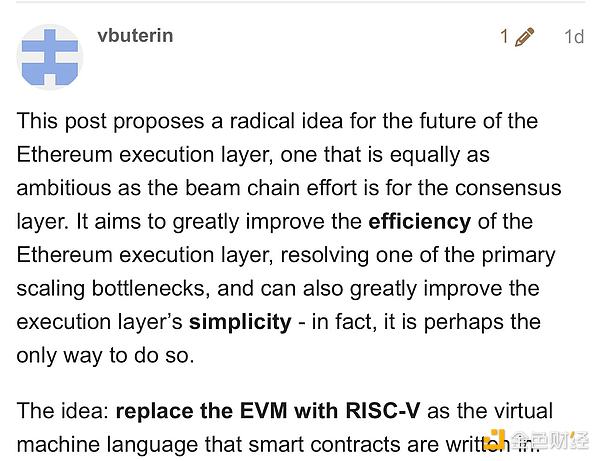Author: binji, former product of Coinbase; Compiler: AIMan@Golden Finance
What exactly is RISC-V? Why are cryptocurrency enthusiasts talking about it?
 Here's an easy-to-understand explanation.
Here's an easy-to-understand explanation.
First of all, RISC-V is not a cryptocurrency, but a real-world computer language that engineers use to build chips and processors... mobile phones, laptops, sensors, etc. It's the program that the computer actually runs.
You may have heard of Intel or ARM chips, which use private, closed instruction sets. RISC-V is the opposite. It's open source. Anyone can build on it, a bit like Linux for computer hardware. It's open + customizable + it's developing rapidly.
So what does this have to do with Ethereum? Ethereum runs smart contracts on a machine called the EVM (Ethereum Virtual Machine), but the EVM, like other virtual machines, is custom built and uses a different language than the rest of the computing world. It's hard to optimize
Many newer technologies, especially zk-proofs, have secretly compiled Ethereum to RISC-V to make things run faster, so the question Vitalik posed this week was: what if Ethereum used RISC-V directly?
Why do this?
Zero-knowledge proofs perform better
Easier to build and maintain in the long term
Aligned with mainstream tools and compilers
Opens a path to simpler and more efficient blockchain designs
But there are some trade-offs, some developers think RISC-V is not designed for Ethereum style, others worry that it will not help with Rollup, and may even make L1 too complicated, which is currently a deep technical debate.
By the way, the transition from EVM to RISC-V is more like changing the engine of a car than the car itself. Vitalik's proposal highlights a way to achieve this goal without re-adjusting too many gears (applications, languages).
It’s worth noting that this is a long-term change, Ethereum’s focus is and should be on more current things (which it is), however, this long-term thinking proves that Ethereum is not just trying to win the next cycle, it’s trying to win the next century.
 Alex
Alex

 Here's an easy-to-understand explanation.
Here's an easy-to-understand explanation.

